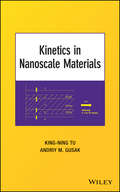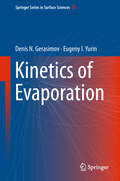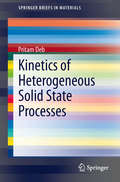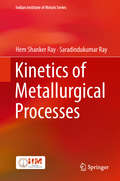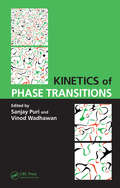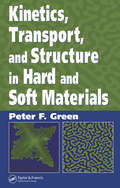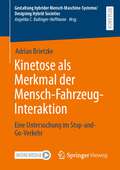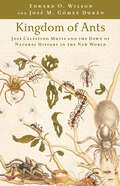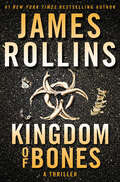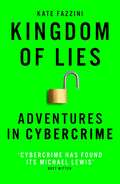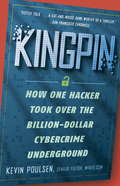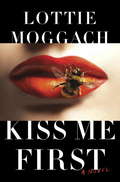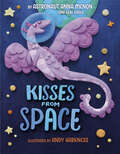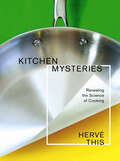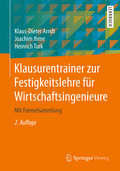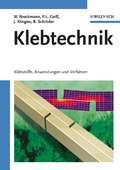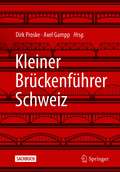- Table View
- List View
Kinetics in Materials Science and Engineering
by Dennis W. Readey"A pedagogical gem…. Professor Readey replaces ‘black-box’ explanations with detailed, insightful derivations. A wealth of practical application examples and exercise problems complement the exhaustive coverage of kinetics for all material classes." –Prof. Rainer Hebert, University of Connecticut "Prof. Readey gives a grand tour of the kinetics of materials suitable for experimentalists and modellers…. In an easy-to-read and entertaining style, this book leads the reader to fundamental, model-based?understanding of kinetic processes critical to development, fabrication and application of commercially-important soft (polymers, biomaterials), hard (ceramics, metals) and composite materials. It is a must-have for anyone who really wants to understand how to make materials and how they will behave in service." --Prof. Bill Lee, Imperial College London, Fellow of the Royal?Academy of Engineering "A much needed text filing the gap between an introductory course in materials science and advanced materials-specific kinetics courses. Ideal for the undergraduate interested in an in-depth study of kinetics in materials." –Prof. Mark E. Eberhart, Colorado School of Mines This book provides an in-depth introduction to the most important kinetic concepts in materials science, engineering, and processing. All types of materials are addressed, including metals, ceramics, polymers, electronic materials, biomaterials, and composites. The expert author with decades of teaching and practical experience gives a lively and accessible overview, explaining the principles that determine how long it takes to change material properties and make new and better materials. The chapters cover a broad range of topics extending from the heat treatment of steels, the processing of silicon integrated microchips, and the production of cement, to the movement of drugs through the human body. The author explicitly avoids "black box" equations, providing derivations with clear explanations.
Kinetics in Nanoscale Materials
by Andriy M. Gusak King-Ning TuAs the ability to produce nanomaterials advances, it becomes more important to understand how the energy of the atoms in these materials is affected by their reduced dimensions. Written by an acclaimed author team, Kinetics in Nanoscale Materials is the first book to discuss simple but effective models of the systems and processes that have recently been discovered. The text, for researchers and graduate students, combines the novelty of nanoscale processes and systems with the transparency of mathematical models and generality of basic ideas relating to nanoscience and nanotechnology.
Kinetics of Evaporation (Springer Series in Surface Sciences #68)
by Denis N. Gerasimov Eugeny I. YurinThis monograph discusses the essential principles of the evaporationprocess by looking at it at the molecular and atomic level.In the first part methods of statistical physics, physical kinetics andnumerical modeling are outlined including the Maxwell’s distributionfunction, the Boltzmann kinetic equation, the Vlasov approach, and theCUDA technique.The distribution functions of evaporating particles are then defined.Experimental results on the evaporation coefficient and the temperaturejump on the evaporation surface are critically reviewed and compared tothe theory and numerical results presented in previous chapters.The book ends with a chapter devoted to evaporation in differentprocesses, such as boiling and cavitation.This monograph addressesgraduate students and researchers working on phase transitions andrelated fields.
Kinetics of Heterogeneous Solid State Processes
by Pritam DebKinetic studies have traditionally being extremely useful in characterizing several physical and chemical phenomena in organic, inorganic and metallic systems. It provides valuable qualitative, quantitative and kinetic information on phase transformations, solid state precipitation, crystallization, oxidation and decomposition. Unfortunately, no single reference comprehensively presents nonisothermal kinetic analysis method for the study of complex processes, determining the actual mechanism and kinetic parameters. This book provides a new method for nonisothermal kinetics and its application in heterogeneous solid state processes. In the backdrop of limitations in existing methods, the book presents a brief review of the widely used isothermal and nonisothermal kinetic analysis methods.
Kinetics of Metallurgical Processes (Indian Institute Of Metals Ser.)
by Hem Shanker Ray Saradindukumar RayThis book is intended as a text for upper undergraduate and graduate courses on kinetics of metallurgical processes for students of materials science, metallurgical engineering, and chemical engineering. Focusing on basic and essential topics, selected from the authors’ teaching and research, it serves as a comprehensive guide to metallurgical kinetics. Chapters 1–10 discuss the “logic” of various kinetics processes, while Chapter 11 explores the systematic analysis of raw rate data generated from controlled experiments. The final chapters illustrate how the fundamental concept of thermal activation is used to describe the kinetics of rate-dependent plastic deformation and creep fracture. With numerous examples, illustrations, and step-by-step tutorials, it is ideally suited for both self-study and classroom use. The examples were selected from research papers to highlight how the topics discussed can be, and are, used to solve real-world technological problems. Providing a comprehensive list of resources for further study, and end-of-chapter review questions to help students test their knowledge, it can be used for university coursework or as a text for professional development courses.
Kinetics of Phase Transitions
by Sanjay Puri Vinod WadhawanProviding a comprehensive introduction with the necessary background material to make it accessible for a wide scientific audience, Kinetics of Phase Transitions discusses developments in domain-growth kinetics. This book combines pedagogical chapters from leading experts in this area and focuses on incorporating various experimentally releva
Kinetics, Transport, and Structure in Hard and Soft Materials
by Peter F. GreenKinetics, Transport, and Structure in Hard and Soft Materials is the only single reference that discusses the connection between structure and mechanisms of atomic or molecular transport in different classes of materials, from metals and semiconductors to network glasses, polymers and supercooled liquids.Divided into four parts, Part
Kinetose als Merkmal der Mensch-Fahrzeug-Interaktion: Eine Untersuchung im Stop-and-Go-Verkehr (Gestaltung hybrider Mensch-Maschine-Systeme/Designing Hybrid Societies)
by Adrian BrietzkeZukünftig können Fahrzeuge automatisiert fahren und Reisende die Fahrzeit zum Video schauen nutzen. Adrian Brietzke untersucht dabei realitätsnah das Auftreten von Kinetose (Reisekrankheit) bei den Reisenden. Es wird ein ganzheitlicher Ansatz beginnend bei der Identifikation der Betroffenengruppe über die empirische Analyse der Ist-Situation im Stop-and-Go-Verkehr bis zu einer Entwicklung und Bewertung von technischen Maßnahmen vorgestellt. Systematisch erhobene Nutzererfahrungen werden ausgewertet sowie das akute Auftreten von Kinetose in Realfahrstudien untersucht. Die gewonnenen Erkenntnisse erlauben eine Überprüfung der Ursachen für Kinetose und liefern Ansätze zur Weiteerentwicklung von Maßnahmen zur Reduzierung von Kinetose.
Kingdom of Ants: José Celestino Mutis and the Dawn of Natural History in the New World
by Edward O. Wilson José M. DuránOne of the earliest New World naturalists, José Celestino Mutis began his professional life as a physician in Spain and ended it as a scientist and natural philosopher in modern-day Colombia. Drawing on new translations of Mutis's nearly forgotten writings, this fascinating story of scientific adventure in eighteenth-century South America retrieves Mutis's contributions from obscurity.In 1760, the 28-year-old Mutis—newly appointed as the personal physician of the Viceroy of the New Kingdom of Granada—embarked on a 48-year exploration of the natural world of northern South America. His thirst for knowledge led Mutis to study the region's flora, become a professor of mathematics, construct the first astronomical observatory in the Western Hemisphere, and amass one of the largest scientific libraries in the world. He translated Newton's writings and penned essays about Copernicus; lectured extensively on astronomy, geography, and meteorology; and eventually became a priest. But, as two-time Pulitzer Prize–winner Edward O. Wilson and Spanish natural history scholar José M. Gómez Durán reveal in this enjoyable and illustrative account, one of Mutis's most magnificent accomplishments involved ants. Acting at the urging of Carl Linnaeus—the father of taxonomy—shortly after he arrived in the New Kingdom of Granada, Mutis began studying the ants that swarmed everywhere. Though he lacked any entomological training, Mutis built his own classification for the species he found and named at a time when New World entomology was largely nonexistent. His unorthodox catalog of army ants, leafcutters, and other six-legged creatures found along the banks of the Magdalena provided a starting point for future study.Wilson and Durán weave a compelling, fast-paced story of ants on the march and the eighteenth-century scientist who followed them. A unique glance into the early world of science exploration, Kingdom of Ants is a delight to read and filled with intriguing information.
Kingdom of Bones: A Sigma Force Novel (Sigma Force #16)
by James RollinsFrom #1 New York Times bestselling author James Rollins, the latest riveting, deeply imaginative thriller in the Sigma Force series, told with his trademark blend of cutting-edge science, historical mystery, and pulse-pounding action.It begins in Africa . . .A United Nations relief team in a small village in the Congo makes an alarming discovery. An unknown force is leveling the evolutionary playing field. Men, women, and children have been reduced to a dull, catatonic state. The environment surrounding them—plants and animals—has grown more cunning and predatory, evolving at an exponential pace. The insidious phenomenon is spreading from a cursed site in the jungle — known to locals as the Kingdom of Bones —and sweeping across Africa, threatening the rest of the world.What has made the biosphere run amok? Is it a natural event? Or more terrifyingly, did someone engineer it?Commander Gray Pierce and Sigma Force are prepared for the extraordinary and have kept the world safe, vigilance for which they have paid a tragic personal price. Yet, even these brilliant and seasoned scientific warriors do not understand what is behind this frightening development—or know how to stop it. As they race to find answers, the members of Sigma quickly realize they have become the prey.To head off global catastrophe, Sigma Force must risk their lives to uncover the shattering secret at the heart of the African continent—a truth that will illuminate who we are as a species and where we may be headed . . . sooner than we know.Mother Nature—red in tooth and claw—is turning against humankind, propelling the entire world into the Kingdom of Bones.
Kingdom of Lies: Unnerving adventures in the world of cybercrime
by Kate FazziniWould you say your phone is safe, or your computer? What about your car? Or your bank? There is a global war going on and the next target could be anyone – an international corporation or a randomly selected individual. From cybercrime villages in Romania to intellectual property theft campaigns in China, these are the true stories of the hackers behind some of the largest cyberattacks in history and those committed to stopping them. You&’ve never heard of them and you&’re not getting their real names. Kate Fazzini has met the hackers who create new cyberweapons, hack sports cars and develop ransomware capable of stopping international banks in their tracks. Kingdom of Lies is a fast-paced look at technological innovations that were mere fantasy only a few years ago, but now make up an integral part of all our lives.
Kingpin: How One Hacker Took Over the Billion-dollar Cyber Crime Underground
by Kevin PoulsenFormer hacker Kevin Poulsen has, over the past decade, built a reputation as one of the top investigative reporters on the cybercrime beat. In Kingpin, he pours his unmatched access and expertise into book form for the first time, delivering a gripping cat-and-mouse narrative--and an unprecedented view into the twenty-first century's signature form of organized crime. The word spread through the hacking underground like some unstoppable new virus: Someone--some brilliant, audacious crook--had just staged a hostile takeover of an online criminal network that siphoned billions of dollars from the US economy. The FBI rushed to launch an ambitious undercover operation aimed at tracking down this new kingpin; other agencies around the world deployed dozens of moles and double agents. Together, the cybercops lured numerous unsuspecting hackers into their clutches. . . . Yet at every turn, their main quarry displayed an uncanny ability to sniff out their snitches and see through their plots. The culprit they sought was the most unlikely of criminals: a brilliant programmer with a hippie ethic and a supervillain's double identity. As prominent "white-hat" hacker Max "Vision" Butler, he was a celebrity throughout the programming world, even serving as a consultant to the FBI. But as the black-hat "Iceman," he found in the world of data theft an irresistible opportunity to test his outsized abilities. He infiltrated thousands of computers around the country, sucking down millions of credit card numbers at will. He effortlessly hacked his fellow hackers, stealing their ill-gotten gains from under their noses. Together with a smooth-talking con artist, he ran a massive real-world crime ring. And for years, he did it all with seeming impunity, even as countless rivals ran afoul of police. Yet as he watched the fraudsters around him squabble, their ranks riddled with infiltrators, their methods inefficient, he began to see in their dysfunction the ultimate challenge: He would stage his coup and fix what was broken, run things as they should be run--even if it meant painting a bull's-eye on his forehead. Through the story of this criminal's remarkable rise, and of law enforcement's quest to track him down, Kingpin lays bare the workings of a silent crime wave still affecting millions of Americans. In these pages, we are ushered into vast online-fraud supermarkets stocked with credit card numbers, counterfeit checks, hacked bank accounts, dead drops, and fake passports. We learn the workings of the numerous hacks--browser exploits, phishing attacks, Trojan horses, and much more--these fraudsters use to ply their trade, and trace the complex routes by which they turn stolen data into millions of dollars. And thanks to Poulsen's remarkable access to both cops and criminals, we step inside the quiet, desperate arms race that law enforcement continues to fight with these scammers today. Ultimately, Kingpin is a journey into an underworld of startling scope and power, one in which ordinary American teenagers work hand in hand with murderous Russian mobsters and where a simple Wi-Fi connection can unleash a torrent of gold worth millions.From the Hardcover edition.
Kiss Me First: Tv Tie-in Edition
by Lottie MoggachA chilling and intense first novel, the story of a solitary young woman drawn into an online world run by a charismatic web guru who entices her into impersonating a glamorous but desperate woman. When Leila discovers the Web site Red Pill, she feels she has finally found people who understand her. A sheltered young woman raised by her mother, Leila has often struggled to connect with the girls at school; but on Red Pill, a chat forum for ethical debate, Leila comes into her own, impressing the Web site's founder, a brilliant and elusive man named Adrian. Leila is thrilled when Adrian asks to meet her, flattered when he invites her to be part of "Project Tess." Tess is a woman Leila might never have met in real life. She is beautiful, urbane, witty, and damaged. As they e-mail, chat, and Skype, Leila becomes enveloped in the world of Tess, learning every single thing she can about this other woman--because soon, Leila will have to become her. An ingeniously plotted novel of stolen identity, Kiss Me First is brilliantly frightening about the lies we tell--to ourselves, to others, for good, and for ill.
Kiss My Boots: Coming Home Book 2 (Coming Home #2)
by Harper SloanKiss My Boots is the second sultry novel in the Coming Home series from New York Times and USA Today bestselling author Harper Sloan. Perfect for fans of Kelly Elliott, Diana Palmer, Jennifer Ryan and Maisey Yates.Quinn Davis is the stereotypical tomboy who prefers to live her life quietly. Of course, it doesn't help that her heart has been hardened when it comes to devilishly handsome cowboys with silver tongues. That is, until Tate Montgomery rides back into town. Growing up, Tate only felt truly at home during the long, sweltering summers at his grandparents' farm in Pine Oak, Texas. Now, Tate has returned to his childhood sanctuary - although if he's honest, he's not just back for the wranglers and Stetsons. Quinn was a friend-turned-young-love who Tate lost when life threw him a curveball. But all it takes is one glance at the raven-haired beauty he did his best to forget for him to realize just how much he's been missing...Want more rugged, charismatic cowboys? Don't miss the rest of this sizzling Texas-set series which began with Lost Rider.
Kisses from Space
by Anna Menon Keri VasekAs Polaris Dawn crewmember, engineer, and mother Anna Menon gets ready to take off into space, she penned this sweet picture book as a love letter to her kids—reimagining their family as a tight-knit clan of adventurous dragons who love each other across any distance!You see, when we&’re apart,we&’re not really alone. I&’ll send kisses from space, and I&’ll always come home.When Anna Menon was offered the chance to become an astronaut on Polaris Dawn, it would fulfill her childhood dream of going to space. But it would also put the largest distance ever between her and her kids. Anna had to consider how she'd connect with her kids as she orbited 870 miles above them at over 15,000 miles per hour.Kisses from Space is the story of a mama dragon coming home from an out-of-this-world adventure and, snuggling her baby dragons close, she tells them of her journey and how she thought of them the entire time. This heartwarming picture book—written in fun, lyrical rhyme and stunningly illustrated—is about the bonds between family members and a mother&’s unwavering love for her children.
Kissing Ezra Holtz (and Other Things I Did for Science)
by Brianna ShrumThe Rosie Project, for teens Seventeen-year-old Amalia Yaabez and Ezra Holtz couldn’t be more different. They’ve known (and avoided) each other their whole lives; she unable to stand his buttoned-up, arrogant, perfect disposition, and he unwilling to deal with her slacker, rule-breaking way of moving through the world. <P><P>When they are unhappily paired on an AP Psychology project, they come across an old psychological study that posits that anyone can fall in love with anyone, if you put them through the right scientific, psychological steps. <P><P>They decide to put that theory to the test for their project, matching couples from different walks of high school life to see if science really can create love. <P><P> As they go through the whirlwind of the experiment, Ezra and Amalia realize that maybe it’s not just the couples they matched who are falling for each other . . .
Kit and Kaboodle Blast Off to Space (Highlights Puzzle Readers)
by Michelle PorticeStories + Puzzles = Reading Success! Highlights Puzzle Readers offer an innovative approach to learning that integrates puzzles and stories to develop motivated, confident readers.Blast off with Kit and Kaboodle as they visit a space camp in this Level 2 Highlights Puzzle Reader. Kids can help the duo by finding items for their journey in six Hidden Pictures puzzles that double as story illustrations. With a bonus picture dictionary, Kit and Kaboodle Blast Off to Space is perfect for readers who are starting to explore reading.
Kitchen Helpers
by Amy TaoSee how the science of physics is utilized not only in the kitchen, but also around the house on a daily basis. Simple machines are everywhere! From brooms and rolling pins to lightbulbs and window blinds, basic everyday kitchen items transform into scientific concepts such as screws, levers, ramps, and wedges!
Kitchen Mysteries: Revealing the Science of Cooking (Arts and Traditions of the Table Perspectives on Culinary History)
by Hervé This&“This&’s molecular gastronomy is garnished with [his] own rich philosophy of food and flavor&” in a book that reveals the science behind everyday cooking (Nature). In Kitchen Mysteries, Hervé This—international celebrity and founder of molecular gastronomy—offers a second helping of his world-renowned insight into the science of cooking, answering such fundamental questions as what causes vegetables to change color when cooked and how to keep a soufflé from falling. He illuminates abstract concepts with practical advice and concrete examples—for instance, how sautéing in butter chemically alters the molecules of mushrooms—so that cooks of every stripe can thoroughly comprehend the scientific principles of food. By sharing the empirical principles chefs have valued for generations, Hervé This adds another dimension to the suggestions of cookbook authors. He shows how to adapt recipes to available ingredients and how to modify proposed methods to the utensils at hand. His revelations make difficult recipes easier to attempt and allow for even more creativity and experimentation. Promising to answer your most compelling kitchen questions, Hervé This continues to make the complex science of food digestible to the cook. &“Cooks who want to learn more about the chemistry and physics that make their efforts possible will discover useful things here.&”—Booklist &“This has made invisible processes visible, revealed the mysteries, and the bread has risen, baked, and been enjoyed.&”—Appetite for Books &“[An] eye-opening book.&”—Portsmouth Herald &“Kitchen Mysteries is another tour de force for the French scientific chef . . . Highly Recommended.&”—Choice
Kitchen Mysteries: Revealing the Science of Cooking (Arts and Traditions of the Table: Perspectives on Culinary History)
by Hervé ThisAn international celebrity and founder of molecular gastronomy, or the scientific investigation of culinary practice, Hervé This is known for his ground-breaking research into the chemistry and physics behind everyday cooking. His work is consulted widely by amateur cooks and professional chefs and has changed the way food is approached and prepared all over the world. In Kitchen Mysteries, Hervé This offers a second helping of his world-renowned insight into the science of cooking, answering such fundamental questions as what causes vegetables to change color when cooked and how to keep a soufflé from falling. He illuminates abstract concepts with practical advice and concrete examples-for instance, how sautéing in butter chemically alters the molecules of mushrooms-so that cooks of every stripe can thoroughly comprehend the scientific principles of food. Kitchen Mysteries begins with a brief overview of molecular gastronomy and the importance of understanding the physiology of taste. A successful meal depends as much on a cook's skilled orchestration of taste, odors, colors, consistencies, and other sensations as on the delicate balance of ingredients. Hervé then dives into the main course, discussing the science behind many meals' basic components: eggs, milk, bread, sugar, fruit, yogurt, alcohol, and cheese, among other items. He also unravels the mystery of tenderizing enzymes and gelatins and the preparation of soups and stews, salads and sauces, sorbet, cakes, and pastries. Hervé explores the effects of boiling, steaming, braising, roasting, deep-frying, sautéing, grilling, salting, and microwaving, and devotes a chapter to kitchen utensils, recommending the best way to refurbish silverware and use copper.By sharing the empirical principles chefs have valued for generations, Hervé This adds another dimension to the suggestions of cookbook authors. He shows how to adapt recipes to available ingredients and how to modify proposed methods to the utensils at hand. His revelations make difficult recipes easier to attempt and allow for even more creativity and experimentation. Promising to answer your most compelling kitchen questions, Hervé This continues to make the complex science of food digestible to the cook.
Kitchen Planning: Guidelines - Codes - Standards
by Julia Beamish Kathleen Parrott JoAnn Emmel Mary Jo PetersonAn essential reference for anyone in the kitchen field. Kitchen Planning contains everything a professional needs to know to design kitchens that are convenient, functional, efficient, and that meet the needs of today's lifestyles.
Kitchen Pollutants Control and Ventilation: A Ventilation Guide to Asian & European Kitchen Environment
by Angui Li Risto KosonenThis book has been written by two experts in ventilation and indoor air quality with vast experience in the field of kitchen ventilation in both Asia and Europe. The authors share their extensive knowledge of the subject and present the results of their research programs as well those of other researchers. Discussing advanced theories of and design approaches for kitchen ventilation, it is a useful reference resource for a wide range of readers, including HVAC researchers, designers and architects.
Klausurentrainer zur Festigkeitslehre für Wirtschaftsingenieure: Mit Formelsammlung
by Klaus-Dieter Arndt Joachim Ihme Heinrich TurkDieser Klausurentrainer bietet prüfungsrelevante Aufgaben mit Lösungen zur Festigkeitslehre für Wirtschafts- und Maschinenbauingenieure. Die Aufgaben sind in drei Schwierigkeitsstufen eingeteilt. Zu jedem Kapitel werden einleitend die notwendigen Formeln und Tabellen angeführt. Pro Thema gibt es Aufgaben mit vollständigem Lösungsweg sowie Aufgaben mit numerischen Ergebnissen und Darstellung des Lösungswegs am Buchende. Wirtschaftliche Aspekte werden in den Aufgabenstellungen und Lösungen berücksichtigt. Die vorliegende Auflage wurde an die 4. Auflage des Lehrbuchs "Festigkeitslehre für Wirtschaftsingenieure“ angepasst.
Klebtechnik: Klebstoffe, Anwendungen und Verfahren
by Jürgen Klingen K. Bernhard Schröder Walter Brockmann Paul Ludwig GeißUm solide, langzeitbestandige und stoffgerechte Klebungen im industriellen oder handwerklichen Bereich herzustellen, sind sowohl gute Grundlagenkenntnisse als auch fachlich fundiertes Wissen von Noten. Die einzelnen Informationen in der vorhandenen Fachliteratur aufzuspuren, ist au?erst muhsam und zeitraubend. Das vorliegende Handbuch - geschrieben von Spezialisten verschiedener Fachbereiche in Forschung und Industrie - vermittelt das vollstandige klebtechnische Wissen in kompakter und ubersichtlicher Form: Neben klassischen Gebieten wie Adhasion, Chemie und charakteristischem Verhalten von Klebstoffen und Klebverbindungen werden insbesondere auch aktuelle praxisrelevante Fragestellungen und die sehr verschiedenartigen Anwendungsmoglichkeiten des Klebens umfassend behandelt - erstmalig in der Literatur.
Kleiner Brückenführer Schweiz
by Dirk Proske Axel GamppDie Schweiz gilt nicht umsonst als ein innovatives Zentrum des weltweiten Brückenbaus. Verschiedene Schweizer Brückenbauer, wie Christan Menn oder Robert Maillart sind weit über die Grenzen der Schweiz bekannt. Dieser kleine Brückenführer Schweiz stellt knapp 20 interessante Brückenkonstruktionen in der Schweiz vor. Dabei handelt es sich nicht ausschließlich um sehr berühmte Bauwerke, aber alle vorgestellten Brückenbauwerke sind auf ihre Art einzigartig und interessant. Der Brückenführer gibt damit einen schönen Überblick über Vielfalt der Brückenkonstruktionen in der Schweiz.

